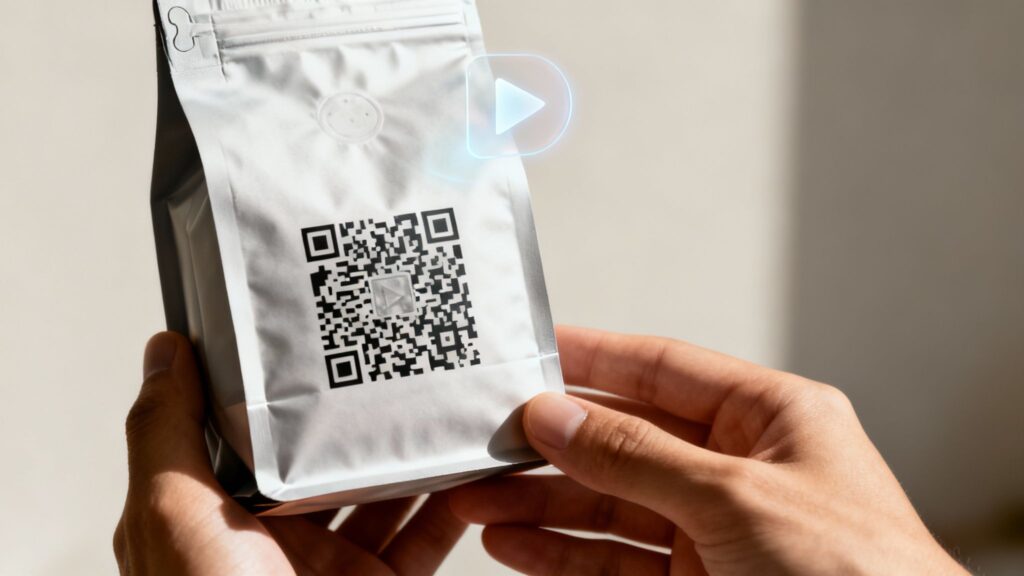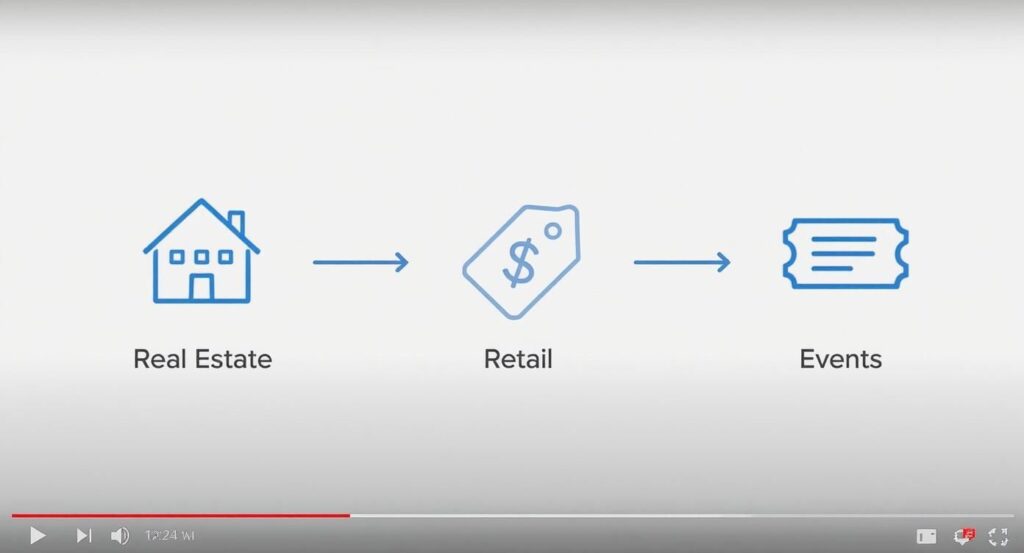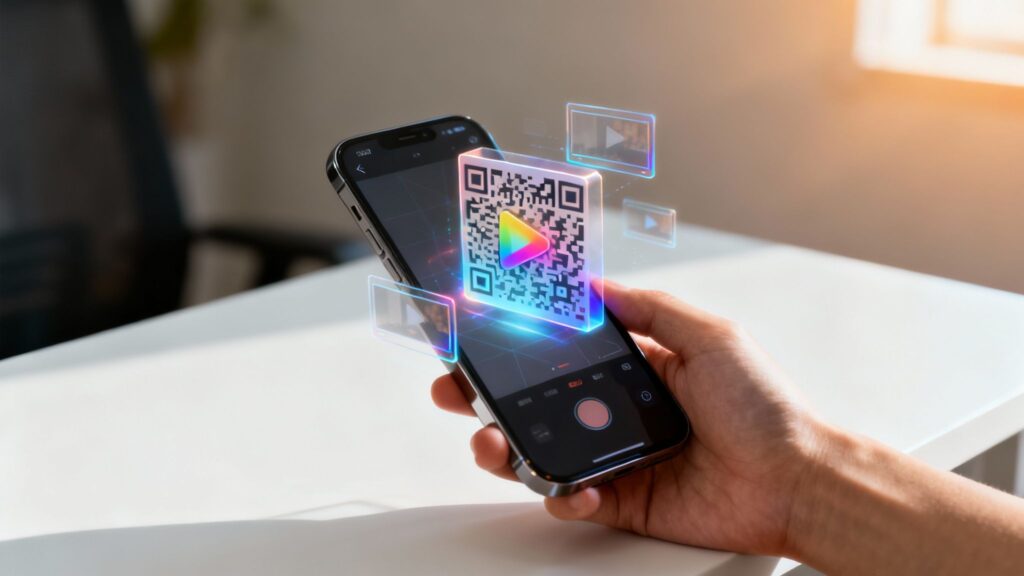Think of a QR code video generator as your secret weapon for connecting the physical world with engaging digital content. Instead of just sending someone to a standard website, you’re dropping them right into an immersive video experience. It’s a simple, powerful way to bridge the gap between your print marketing and the dynamic content that actually grabs people’s attention. With a tool like OpenQR, you can create a scannable link that turns a static object into an interactive gateway.
What is a Video QR Code?

Let’s cut through the tech talk. A video QR code is a scannable image that, when scanned with a smartphone, directs the user straight to a video. It acts as a shortcut from a real-world object—like product packaging, a flyer, or a business card—to a compelling digital experience.
Unlike a standard QR code that usually leads to a text-heavy website, a video QR code gets straight to the point with content that’s proven to perform better. The QR code itself doesn’t contain the video file; instead, it holds the URL where the video is hosted online. This makes it a lightweight and efficient way to deliver rich media content instantly.
What information can I display on a QR Code Video?
When you use a QR code video generator like OpenQR, you aren’t just linking to a video. You can create a mobile-optimized landing page that surrounds your video with valuable context. This turns a simple scan into a complete marketing touchpoint. Your page can include:
- The Video Itself: Hosted on platforms like YouTube, Vimeo, or your own server.
- A Captivating Headline: To grab attention and explain what the video is about.
- Descriptive Text: Add extra details, instructions, or a brief story.
- A Clear Call-to-Action (CTA) Button: Guide users to the next step, like “Shop Now,” “Learn More,” or “Book a Demo.”
- Company Branding: Feature your logo and brand colors to create a cohesive experience.
- Social Media Links: Encourage users to connect with you on other platforms.
Why do I need a QR Code Video?
In a market where everyone’s fighting for a few seconds of attention, video is king. A QR code for video is the most direct way to get that engaging content in front of your audience at the exact moment they are curious.
This direct approach has some serious perks:
- Boost Engagement Instantly: People are far more likely to watch a short video than read a wall of text. Visual content is more memorable and effective.
- Provide a Seamless User Experience: You remove all friction. There’s no need to type in a long URL or search for your video online. It’s just one scan, and they’re watching.
- Enhance Marketing Versatility: The possibilities are endless. You can place QR codes on print ads, product labels, event banners, restaurant menus, real estate signs—virtually anywhere.
- Trackable Performance: With dynamic QR codes, you can measure every scan, giving you valuable data on when, where, and how your audience is engaging with your content.
The dynamic QR code generator market is on track to hit around $500 million in 2025, expanding at a compound annual growth rate of about 15%. This growth is fueled by the demand for interactive, contactless experiences that video QR codes deliver perfectly.
How to create QR Codes for video with OpenQR
Creating a video QR code is a straightforward process, especially with a user-friendly platform. OpenQR helps you generate, customize, and manage your codes in a few simple steps, turning your video content into a powerful marketing tool. Here’s how to solve the problem of connecting your physical and digital worlds.
Step 1: Get Your Video URL
First, your video needs to be hosted online. A QR code works by linking to a URL. You have several options:
- YouTube or Vimeo: The most common choice. Upload your video, grab the shareable link, and you’re ready.
- Social Media: Link directly to a video on Instagram, TikTok, or Facebook to boost your social channels.
- Your Own Website: If you host videos on your server, you can use that direct URL for complete control over the viewing experience.
No matter where it lives, make sure the link is public and accessible.
Step 2: Create a Dynamic QR Code in OpenQR
Log in to your OpenQR account and select the URL QR code type. You’ll face a key decision: static vs. dynamic. For any business purpose, always choose dynamic.
A dynamic QR code is your secret weapon. It allows you to change the destination video link after the QR code has been printed. You can update a promotion, fix a broken link, or swap seasonal content without reprinting anything. This flexibility is a game-changer.
Paste your video URL into the designated field. OpenQR will instantly generate your code.
Step 3: Customize Your QR Code for Higher Engagement
A branded QR code gets more scans. It builds trust and looks professional. Use OpenQR’s customization tools:
- Add Your Logo: Place your logo in the center of the code to reinforce brand identity.
- Use Brand Colors: Match the code’s colors to your brand palette. Just ensure there’s enough contrast between the foreground and background for easy scanning.
- Add a Frame with a CTA: Include a frame that says “Scan to Watch” or “See How It Works.” This tells users exactly what to do and why they should.
Step 4: Download and Test Your Code
Once you’re happy with the design, download the QR code. OpenQR provides different formats:
- PNG: Best for digital use (websites, emails).
- SVG: A vector format perfect for print. You can resize it for anything from a business card to a billboard without losing quality.
Crucially, test your QR code before deploying it. Scan it with multiple devices (iPhone and Android) to ensure it links to the correct video and that the video plays properly. This simple check prevents costly mistakes.
This infographic breaks down how different industries are using video QR codes to solve real-world problems.

As you can see, the applications are incredibly versatile, from virtual property tours in real estate to interactive event guides that enhance the attendee experience.
Real world use cases for Video QR Codes
The true magic of a QR code video generator comes alive when you see how it solves real problems for real businesses. These little scannable squares are turning static objects into dynamic, interactive experiences and changing how brands connect with their audiences.
Here are some practical, real-world examples:
- Retail & Product Packaging: A customer in a store is looking at your product. They scan a QR code on the packaging and instantly watch a video demonstrating how to use it, showcasing its features, or sharing customer testimonials. This helps them make a purchase decision on the spot.
- Real Estate: A “For Sale” sign is no longer just a sign. A QR code allows passersby to take an immediate virtual video tour of the property, capturing leads and interest 24/7 without an agent present.
- Restaurants & Hospitality: A QR code on a menu next to a signature dish can link to a video of the chef preparing it. This tells a story, builds anticipation, and enhances the dining experience. In hotels, a QR code in the room can provide a video welcome message from the manager or a tour of the amenities.
- Events & Conferences: Place QR codes on event badges or programs. Attendees can scan them to watch a welcome video, access session highlights, or view a daily recap. This keeps them engaged and informed.
- Manufacturing & Training: A QR code placed on a piece of machinery can link to a safety demonstration or a step-by-step operational guide. This improves safety, reduces training time, and empowers employees with on-demand information.
In every one of these scenarios, using a dynamic QR code from a platform like OpenQR is what makes the strategy truly powerful. The restaurant can update its video weekly, the real estate agent can change the listing video, and the manufacturer can update safety protocols—all without ever reprinting the physical QR code. This flexibility is a massive advantage, saving time, money, and logistical headaches.
Choosing Between Static and Dynamic Codes
Deciding whether to go with a static or dynamic QR code can feel technical, but it’s actually a simple choice based on your project’s needs. Here’s a quick breakdown to help you decide.
Static vs Dynamic Video QR Codes Which to Choose
| Feature | Static QR Code | Dynamic QR Code (Recommended) |
|---|---|---|
| Editability | Cannot be changed once created. The video URL is permanent. | The video URL can be edited anytime, even after printing. |
| Tracking | No scan tracking or analytics are available. | Provides detailed analytics: scan counts, location, time, and device type. |
| Longevity | Good for permanent links that will never change (e.g., an archived video). | Ideal for marketing campaigns, product packaging, and business cards where content may need updating. |
| Best For | One-off personal projects or information that will never expire. | All business and marketing purposes, ongoing promotions, and any situation where you want to measure engagement. |
Ultimately, while static codes have their place for permanent, unchanging information, the flexibility and data-rich insights from dynamic QR codes make them the superior choice for virtually any professional application. While you’re at it, it’s worth checking out some of the best AI video generator tools to speed up your workflow for creating new content. Our complete guide offers even more practical tips on how to create a QR code for a video and get it right the first time.
Getting Your Video QR Code Out in the Wild
You’ve built the perfect QR code for your video. Great! But the real test is what happens next. A brilliant code that’s hard to scan or in the wrong spot is just a missed connection. Let’s talk about how to deploy it effectively so people actually use it.
The two biggest culprits I see for failed QR campaigns are size and placement. People often print them way too small. As a baseline, your QR code should never be smaller than 1 x 1 inch (2.5 x 2.5 cm). But that’s just a starting point—think about the scanning distance. A code on a business card is different from one on a tradeshow banner across the room. The further away people are, the bigger that code needs to be.
Put Your Code in the Right Place (With the Right Instructions)
Where you stick your code is just as important as how big it is. Glare is a killer, so avoid highly reflective surfaces like glass windows or super glossy posters. The camera just won’t be able to read it. Also, think about the environment. Is there decent cell service or Wi-Fi? A QR code in a subway tunnel or a concrete basement is a recipe for frustration.
And please, don’t leave people guessing. You have to tell them what to do and why they should bother. A solid call-to-action (CTA) makes all the difference.
- Be Specific: Instead of a lazy “Scan Me,” try something like “Scan to See It in Action” or “Watch Our Quick Tutorial.” It sets a clear expectation.
- Create a Little Urgency: “Scan for a Limited-Time Offer” can nudge someone to act now instead of later.
- Solve a Problem: On a product box, a CTA like “Scan for Easy Assembly Instructions” is incredibly helpful and shows immediate value.
Your goal is to eliminate any friction or confusion. A clear CTA tells people exactly what they’re getting, turning a passing glance into an intentional scan. If the benefit is obvious, they’re far more likely to pull out their phone.
Don’t Just Deploy—Measure and Adapt
This is where choosing a dynamic QR code video generator like OpenQR really pays off. A static code is a one-and-done deal; you launch it and hope for the best, with no clue if it’s actually working. Dynamic codes, on the other hand, give you the data you need to see what’s happening.
With OpenQR’s analytics, you can see the story behind the scans in real-time:
- Total Scans: The most basic metric—are people actually engaging?
- Location Data: Find out which cities or regions are scanning the most. This is gold for figuring out where your marketing is hitting home.
- Time of Day: Learn the peak times your audience is active.
- Device Type: See the breakdown between iOS and Android users.
This kind of feedback is crucial for understanding the ROI of your campaign. If a code at a local event drives a huge spike in scans from that city, you know you did something right. But if the code on your new packaging gets almost no activity after a month, that’s your cue to rethink its placement or CTA. To dig deeper into what works and what doesn’t, check out our complete guide on QR code best practices and sidestep those common mistakes. For more ideas, you can use tools for generating Instagram Reels from existing blog content to create short videos perfect for QR code linking.
Common Questions About Video QR Codes
Once you start making QR codes for your videos, you’ll probably run into a few questions. I’ve heard them all over the years. Getting these things straight from the get-go will save you a lot of headaches and help you get much better results.
Let’s dive into the most common ones I hear.
Can I Link a QR Code to a Video on My Phone?
This is easily one of the most frequent mix-ups. People want to know if they can just point a QR code to a video file saved on their phone. The short answer is no, and there’s a really practical reason for it.
A QR code is basically just a shortcut to a web address. For anyone to scan it and see your video, that video has to live at a public URL on the internet. If the file is just sitting on your phone, there’s no public address for the code to point to.
To get around this, you first need to upload your video somewhere online. Platforms like YouTube or Vimeo are perfect for this, but your own company server works too. Once uploaded, you’ll get a stable, shareable URL. That’s the link you use to create your QR code.
Do Video QR Codes Expire?
This is a big one. Whether your QR code has a shelf-life comes down to the type you create: static or dynamic. Understanding the difference is critical, especially for any business or marketing campaign.
- Static QR Codes: These are permanent and unchanging. The video URL is baked directly into the QR code’s pattern. The good news? It will work forever. The bad news? You can never change that URL once the code is made.
- Dynamic QR Codes: This is the kind you’ll create with a platform like OpenQR. The code itself points to a special, short redirect link that you control from your account. This means the code never expires as long as your account is active, and you can swap out the destination video anytime you want without reprinting a single thing.
For any serious, professional project, dynamic codes are a no-brainer. The flexibility to update your video or fix a broken link is a lifesaver for your marketing materials.
How Do I Track My QR Code Performance?
Here’s where you see the real magic of a dynamic QR code video generator. A static code is a black box; once you print it, you have zero clue if anyone is actually scanning it. It’s like putting up a billboard with your eyes closed.
Dynamic QR codes, on the other hand, come with a full analytics dashboard. Tools like OpenQR build this right in, giving you the hard data you need to see what’s working. From your account, you can track essential metrics like:
- Total number of scans
- The city and country where scans are happening
- The specific time and date of each scan
- What kind of device was used (iPhone, Android, etc.)
This isn’t just nice-to-have information. It’s crucial for understanding how people are interacting with your materials and proving that your print campaigns are actually delivering results. While we’re focused on video here, it’s just one of many possibilities. You might want to check out our guide on all the different QR code types you can create.
Ready to create video experiences that truly connect with your audience? With OpenQR, you can generate, customize, and track dynamic video QR codes in just a few minutes. Start your free trial today and see the difference it makes. Visit OpenQr dashboard to get started.
